Page 325 of 532
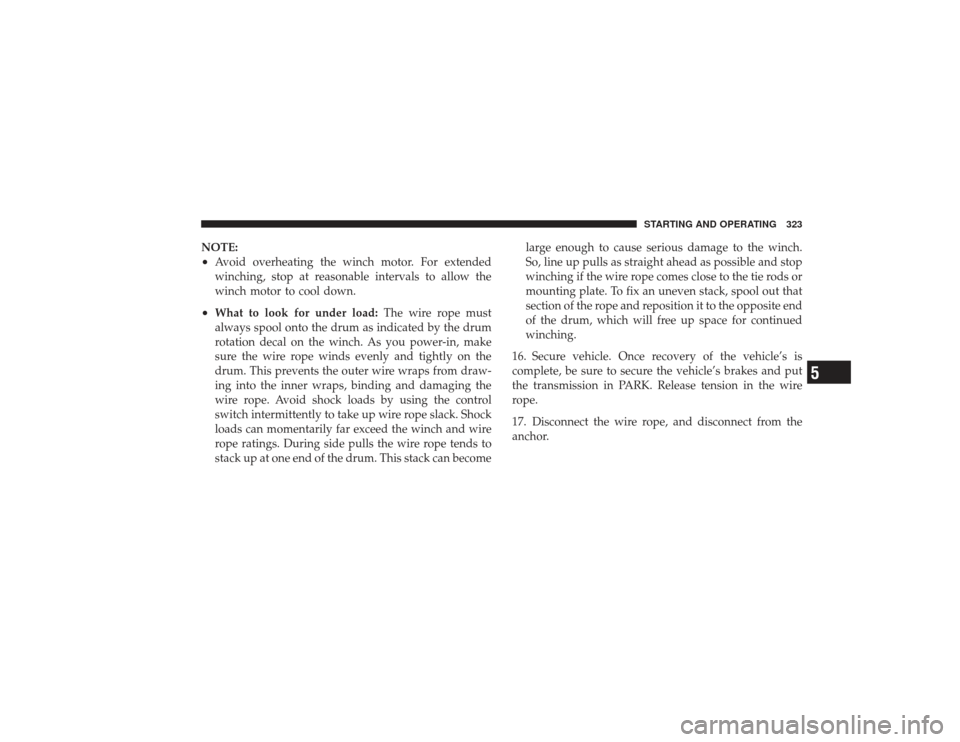
NOTE:•
Avoid overheating the winch motor. For extended
winching, stop at reasonable intervals to allow the
winch motor to cool down.
•
What to look for under load:The wire rope must
always spool onto the drum as indicated by the drum
rotation decal on the winch. As you power-in, make
sure the wire rope winds evenly and tightly on the
drum. This prevents the outer wire wraps from draw-
ing into the inner wraps, binding and damaging the
wire rope. Avoid shock loads by using the control
switch intermittently to take up wire rope slack. Shock
loads can momentarily far exceed the winch and wire
rope ratings. During side pulls the wire rope tends to
stack up at one end of the drum. This stack can become large enough to cause serious damage to the winch.
So, line up pulls as straight ahead as possible and stop
winching if the wire rope comes close to the tie rods or
mounting plate. To fix an uneven stack, spool out that
section of the rope and reposition it to the opposite end
of the drum, which will free up space for continued
winching.
16. Secure vehicle. Once recovery of the vehicle’s is
complete, be sure to secure the vehicle’s brakes and put
the transmission in PARK. Release tension in the wire
rope.
17. Disconnect the wire rope, and disconnect from the
anchor.
STARTING AND OPERATING 323
5
Page 332 of 532
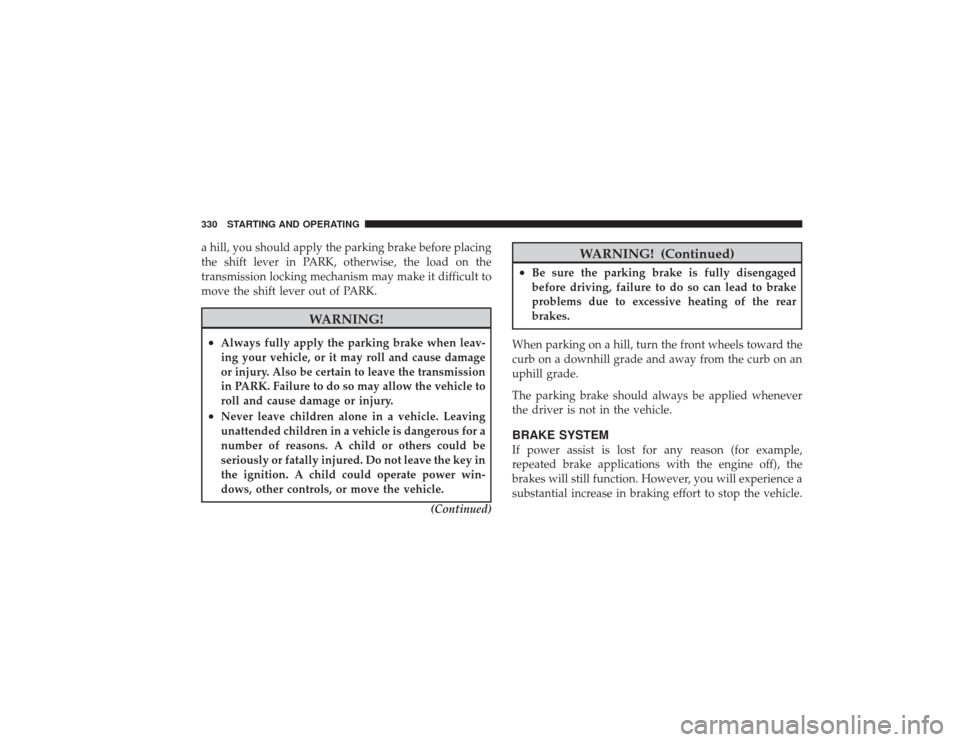
a hill, you should apply the parking brake before placing
the shift lever in PARK, otherwise, the load on the
transmission locking mechanism may make it difficult to
move the shift lever out of PARK.
WARNING!
•
Always fully apply the parking brake when leav-
ing your vehicle, or it may roll and cause damage
or injury. Also be certain to leave the transmission
in PARK. Failure to do so may allow the vehicle to
roll and cause damage or injury.
•
Never leave children alone in a vehicle. Leaving
unattended children in a vehicle is dangerous for a
number of reasons. A child or others could be
seriously or fatally injured. Do not leave the key in
the ignition. A child could operate power win-
dows, other controls, or move the vehicle.(Continued)
WARNING! (Continued)
•
Be sure the parking brake is fully disengaged
before driving, failure to do so can lead to brake
problems due to excessive heating of the rear
brakes.
When parking on a hill, turn the front wheels toward the
curb on a downhill grade and away from the curb on an
uphill grade.
The parking brake should always be applied whenever
the driver is not in the vehicle.
BRAKE SYSTEMIf power assist is lost for any reason (for example,
repeated brake applications with the engine off), the
brakes will still function. However, you will experience a
substantial increase in braking effort to stop the vehicle.
330 STARTING AND OPERATING
Page 339 of 532
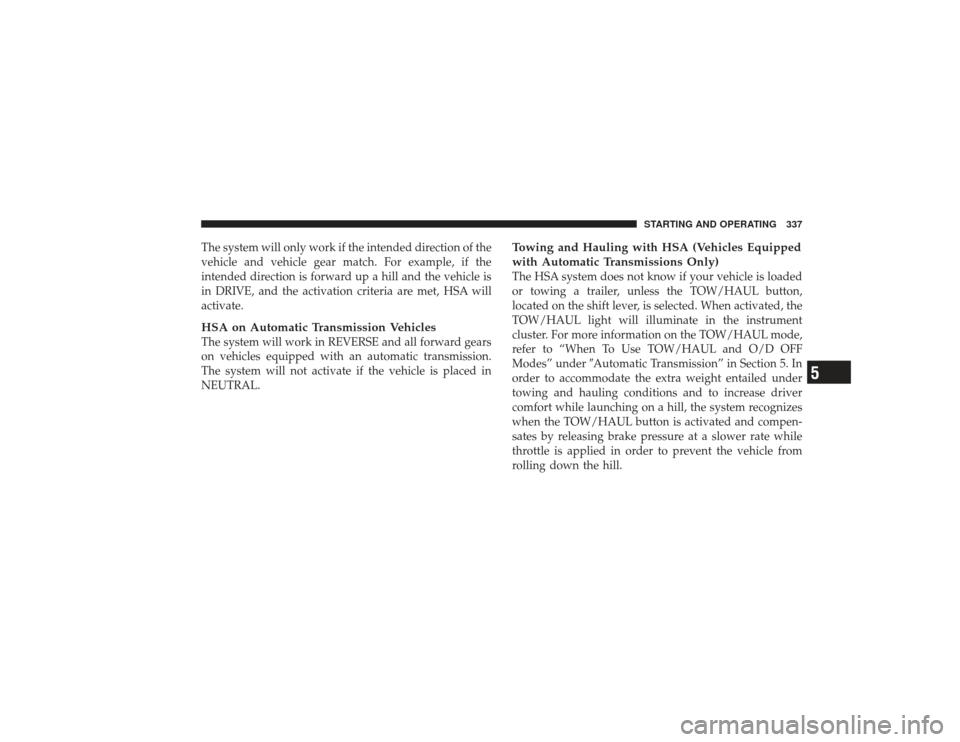
The system will only work if the intended direction of the
vehicle and vehicle gear match. For example, if the
intended direction is forward up a hill and the vehicle is
in DRIVE, and the activation criteria are met, HSA will
activate.HSA on Automatic Transmission VehiclesThe system will work in REVERSE and all forward gears
on vehicles equipped with an automatic transmission.
The system will not activate if the vehicle is placed in
NEUTRAL.
Towing and Hauling with HSA (Vehicles Equipped
with Automatic Transmissions Only)The HSA system does not know if your vehicle is loaded
or towing a trailer, unless the TOW/HAUL button,
located on the shift lever, is selected. When activated, the
TOW/HAUL light will illuminate in the instrument
cluster. For more information on the TOW/HAUL mode,
refer to “When To Use TOW/HAUL and O/D OFF
Modes” under�Automatic Transmission” in Section 5. In
order to accommodate the extra weight entailed under
towing and hauling conditions and to increase driver
comfort while launching on a hill, the system recognizes
when the TOW/HAUL button is activated and compen-
sates by releasing brake pressure at a slower rate while
throttle is applied in order to prevent the vehicle from
rolling down the hill.
STARTING AND OPERATING 337
5
Page 340 of 532
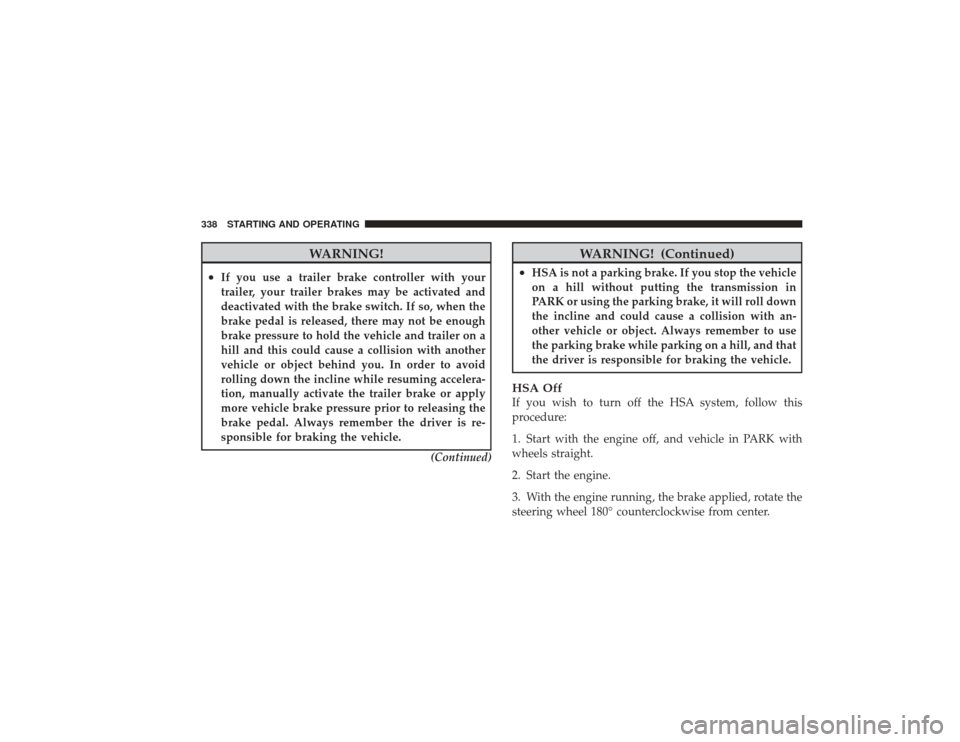
WARNING!
•
If you use a trailer brake controller with your
trailer, your trailer brakes may be activated and
deactivated with the brake switch. If so, when the
brake pedal is released, there may not be enough
brake pressure to hold the vehicle and trailer on a
hill and this could cause a collision with another
vehicle or object behind you. In order to avoid
rolling down the incline while resuming accelera-
tion, manually activate the trailer brake or apply
more vehicle brake pressure prior to releasing the
brake pedal. Always remember the driver is re-
sponsible for braking the vehicle.(Continued)
WARNING! (Continued)
•
HSA is not a parking brake. If you stop the vehicle
on a hill without putting the transmission in
PARK or using the parking brake, it will roll down
the incline and could cause a collision with an-
other vehicle or object. Always remember to use
the parking brake while parking on a hill, and that
the driver is responsible for braking the vehicle.
HSA OffIf you wish to turn off the HSA system, follow this
procedure:
1. Start with the engine off, and vehicle in PARK with
wheels straight.
2. Start the engine.
3. With the engine running, the brake applied, rotate the
steering wheel 180° counterclockwise from center.
338 STARTING AND OPERATING
Page 393 of 532
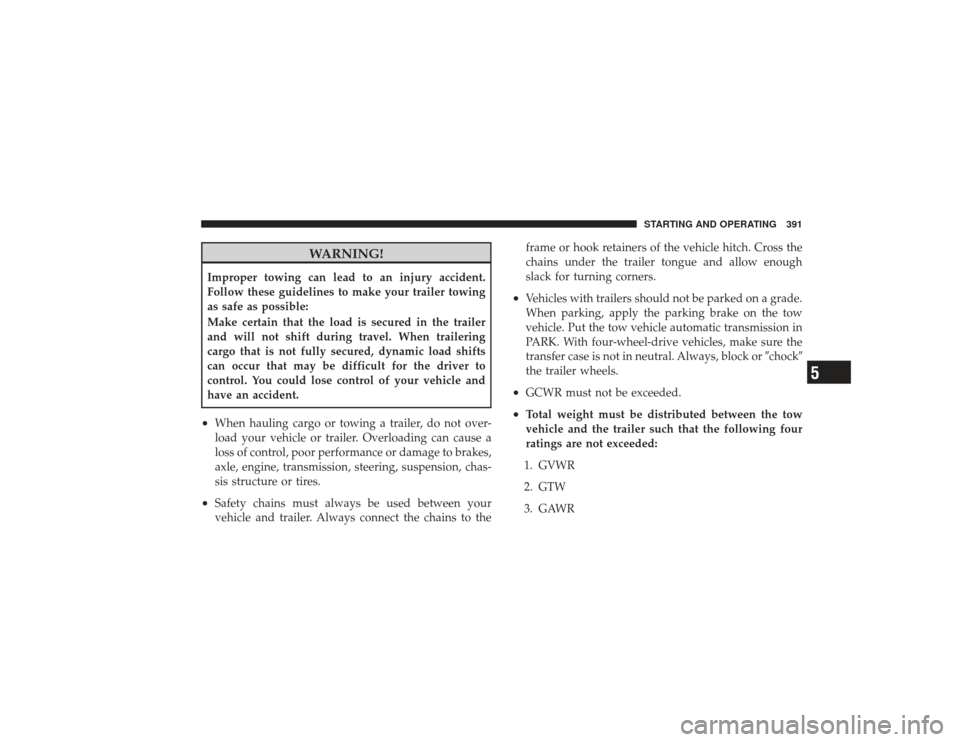
WARNING!
Improper towing can lead to an injury accident.
Follow these guidelines to make your trailer towing
as safe as possible:
Make certain that the load is secured in the trailer
and will not shift during travel. When trailering
cargo that is not fully secured, dynamic load shifts
can occur that may be difficult for the driver to
control. You could lose control of your vehicle and
have an accident.•
When hauling cargo or towing a trailer, do not over-
load your vehicle or trailer. Overloading can cause a
loss of control, poor performance or damage to brakes,
axle, engine, transmission, steering, suspension, chas-
sis structure or tires.
•
Safety chains must always be used between your
vehicle and trailer. Always connect the chains to theframe or hook retainers of the vehicle hitch. Cross the
chains under the trailer tongue and allow enough
slack for turning corners.
•
Vehicles with trailers should not be parked on a grade.
When parking, apply the parking brake on the tow
vehicle. Put the tow vehicle automatic transmission in
PARK. With four-wheel-drive vehicles, make sure the
transfer case is not in neutral. Always, block or
�chock�
the trailer wheels.
•
GCWR must not be exceeded.
•
Total weight must be distributed between the tow
vehicle and the trailer such that the following four
ratings are not exceeded:
1. GVWR
2. GTW
3. GAWR
STARTING AND OPERATING 391
5
Page 397 of 532

WARNING!
Any work done to the vehicles electrical system, or
wiring, should be performed by a qualified automo-
tive technician, if done improperly it may cause
damage to the electrical system wiring and could
result in serious or fatal injury.Towing TipsBefore setting out on a trip, practice turning, stopping
and backing the trailer in an area away from heavy
traffic.Automatic TransmissionThe “DRIVE” range can be selected when towing. How-
ever, if frequent shifting occurs while in this range, the
“TOW HAUL” or “OD/OFF” range should be selected.NOTE:
Using the “TOW HAUL” or “OD/OFF” range
while operating the vehicle under heavy operating con-
ditions will improve performance and extend transmis-
sion life by reducing excessive shifting and heat build up.
This action will also provide better engine braking.
The automatic transmission fluid and filter should be
changed if you REGULARLY tow a trailer for more than
45 minutes of continuous operation. Refer to the “Main-
tenance Schedule” in Section 8 for the proper mainte-
nance intervals.
NOTE: Check the automatic transmission fluid level
before towing.
Tow/Haul — If EquippedTo reduce potential for automatic transmission overheat-
ing, turn the “TOW HAUL OD/OFF” feature ON when
driving in hilly areas or shift the transmission to Drive
position 2 on more severe grades.
STARTING AND OPERATING 395
5
Page 398 of 532
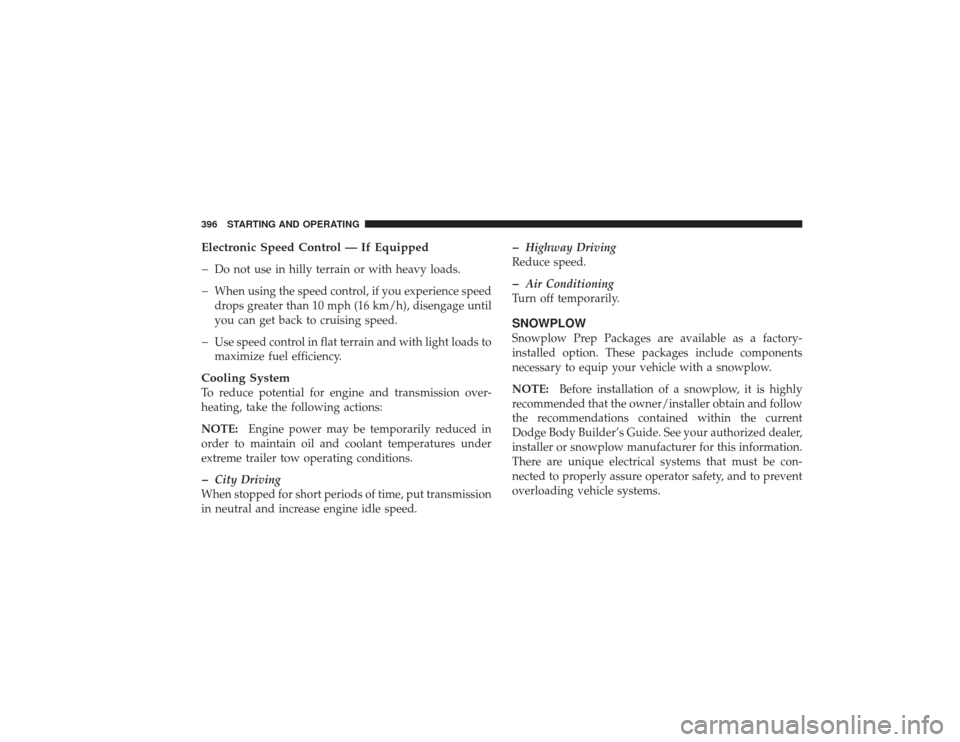
Electronic Speed Control — If Equipped
�
Do not use in hilly terrain or with heavy loads.
�
When using the speed control, if you experience speed
drops greater than 10 mph (16 km/h), disengage until
you can get back to cruising speed.
�
Use speed control in flat terrain and with light loads to
maximize fuel efficiency.
Cooling SystemTo reduce potential for engine and transmission over-
heating, take the following actions:
NOTE: Engine power may be temporarily reduced in
order to maintain oil and coolant temperatures under
extreme trailer tow operating conditions.�
City Driving
When stopped for short periods of time, put transmission
in neutral and increase engine idle speed.
�
Highway Driving
Reduce speed.
�
Air Conditioning
Turn off temporarily.
SNOWPLOWSnowplow Prep Packages are available as a factory-
installed option. These packages include components
necessary to equip your vehicle with a snowplow.
NOTE: Before installation of a snowplow, it is highly
recommended that the owner/installer obtain and follow
the recommendations contained within the current
Dodge Body Builder’s Guide. See your authorized dealer,
installer or snowplow manufacturer for this information.
There are unique electrical systems that must be con-
nected to properly assure operator safety, and to prevent
overloading vehicle systems.
396 STARTING AND OPERATING
Page 399 of 532

WARNING!
Attaching a snowplow to this vehicle could adversely
affect performance of the airbag system in an acci-
dent. Do not expect that the airbag will perform as
described earlier in this manualRECREATIONAL TOWING (BEHIND
MOTORHOME, ETC.)
CAUTION!
Front or rear wheel lifts should not be used. Internal
damage to the transmission or transfer case will occur
if a front or rear wheel lift is used when recreational
towing.
Recreational Towing – Two-Wheel Drive ModelsRecreational towing of two-wheel drive models is not
allowed.Towing with the rear wheels on the ground can
result in severe transmission damage.Recreational Towing – Four-Wheel Drive Models
CAUTION!
Failure to follow these requirements can cause severe
damage to the transmission and/or transfer case.
NOTE: Both the manual shift and electronic shift trans-
fer cases must be shifted into NEUTRAL for recreational
towing. Automatic transmissions must be shifted into the
PARK position for recreational towing. Refer to the
following for the proper transfer case NEUTRAL shifting
procedure for your vehicle.
STARTING AND OPERATING 397
5